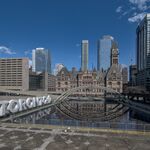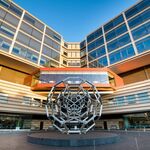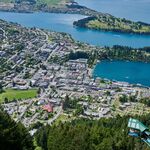Leo_Chan
Senior Member
Now if they introduced a viewable 3D model of many stations that anyone can view online, then that would be cool.Once again Metrolinx posts a years old video .. .
Now if they introduced a viewable 3D model of many stations that anyone can view online, then that would be cool.Once again Metrolinx posts a years old video .. .
Not sure if this is new but Metrolinx shared this walkthrough of Kennedy Station
Once again Metrolinx posts a years old video .. .
I just wish they would actually show details people want to see like for example will the LRT have asperete fare line from the subway sationNow if they introduced a viewable 3D model of many stations that anyone can view online, then that would be cool.
What makes you say that? The Relief Line is being built as a subway with ATC. The Yonge Line once ATC is implemented can handle 36,000pphd. The Relief Line if built to Sheppard is only projected to be 19,200 pphd in 2031. That is plenty of room for growth.But the Relief Line as being proposed couldn't handle the volume necessary, or if it did, it would dump it on the subway still, which is exactly what's trying to be avoided.
Then bypass the subway altogether instead of band-aid solutions.
If we threw the Relief Line on the RH-GO corridor and sent the trains up to Richmond Hill, there are two things that go in our favour: (1) The Relief Line provides full relief to the Yonge Line by accepting downtown-bound York Region riders, freeing up capacity further down the line; (2) The trip actually will save passengers time compared to the Yonge Line as the Relief Line would have higher operating speeds between Richmond Hill and Pape (and less stations to slow down).
Of course, the converse of that is that the preliminary ridership projections for the various routes have the ridership increasing the further away you get from Yonge. The Bala Sub comes back and almost reaches Yonge at Highway 7.
And then there's the fact that there is no established ridership patterns on the Bala Sub - people are simply using it as a bridge route to get from one end to the other. Running the DRL up Don Mills or Victoria Park would not just intercept people heading downtown, but also take advantage of the existing on-line ridership patterns as well.
Dan
Toronto, Ont.

This thread is getting a bit off topic, but I agree with you on this. Using the Richmond Hill Line for the Relief Line North has a very low possibility of happening, even though it is identified as a potential corridor on the long list of corridors. At this time, we should wait a few more months or years until they release their short list of corridors to see if they find it attractive.For everyone suggesting using the Bala sub for the DRL, stop, just, please stop. It is the mainline in for CN from the west.
That would be akin to suggesting that we turn the 400 into a new LRT.
Unless it was tunnelled.For everyone suggesting using the Bala sub for the DRL, stop, just, please stop. It is the mainline in for CN from the west.
For everyone suggesting using the Bala sub for the DRL, stop, just, please stop. It is the mainline in for CN from the west.
That would be akin to suggesting that we turn the 400 into a new LRT.
For where? Not for *circumventing the load on the present subway it was never designed for*. Anyone thinking extending the present groaning yesterday's subway further out to the nether regions in lieu of regional rail is a good idea is a supporter of Doug Ford. It was never meant to handle that, and it never will as is. Extensions are *exacerbating the very reason touted for the Pape south relief case exists in the first place*. Eglinton Crosstown does the opposite, albeit it too will further load legs of the present subway Line 1. That's something to cater for, and will again max out the present groaning subway infrastructure not designed for serving the regions.That is plenty of room for growth.
It doesn't "add up" because like many Toronto centric persons, you miss the bigger picture as is being done in many world leading cities.Not to mention it's based on the rather callous and silly assumption that we'll simply shutter a 4km section of long-existing commuter rail, shutter 8km of new track and a brand new station (gormely), and stop work on Bloomington which is quite far along in construction. Sort of gas plant-ish. I get upgrading a commuter rail line to subway standards. Not tossing a rail line aside. This resulting in, what, two subway lines to an outer suburban area all the while we have swaths of the real city dying for major upgrades to transit or SSE getting only one station. Doesn't add up.
And it's also the proposed entrance into Union for HFR. Does that then mean that "CN" can no longer use the southern leg of it? (HFR is inevitably going to be electrified, and ML has already made provisions for electrifying the bend into the USRC.)For everyone suggesting using the Bala sub for the DRL, stop, just, please stop. It is the mainline in for CN from the west.
When you say "alternative", do you mean a new primary option, a new secondary option, a new back up option, a new route for redundancy or all of the above?The Line 5 Eglinton Crosstown LRT will be an alternative to the Line 2 Bloor-Danforth. While the University-Spadina leg is an alternative to the Yonge leg of the Line 1, any stoppages anywhere on Line 1 could stop all movements on Line 1. Even the Finch West LRT will be alternative for east-west travel, should they go through with its possible extensions.
It doesn't "add up" because like many Toronto centric persons, you miss the bigger picture as is being done in many world leading cities.
You *feed* that traffic into the Relief Line tunnel. The whole Bala line *remains*. What is now extant below Don Mills becomes a direct express peak service to Union below Don Mills as it now is and for any other existing heavy rail needs. The DD stock won't fit in a 6.5 metre bore. Single decker emu that runs on standard UIC height 25 kV AC catenary can and does! In Toronto's case, I recommend a slightly larger bore, but Crossrail and other European cities do it in a bore size now standard for later Toronto subway tunnels. Paris even does DD in that size bore! Sydney slightly larger IIRC.
For everyone suggesting using the Bala sub for the DRL, stop, just, please stop. It is the mainline in for CN from the west.
That would be akin to suggesting that we turn the 400 into a new LRT.




